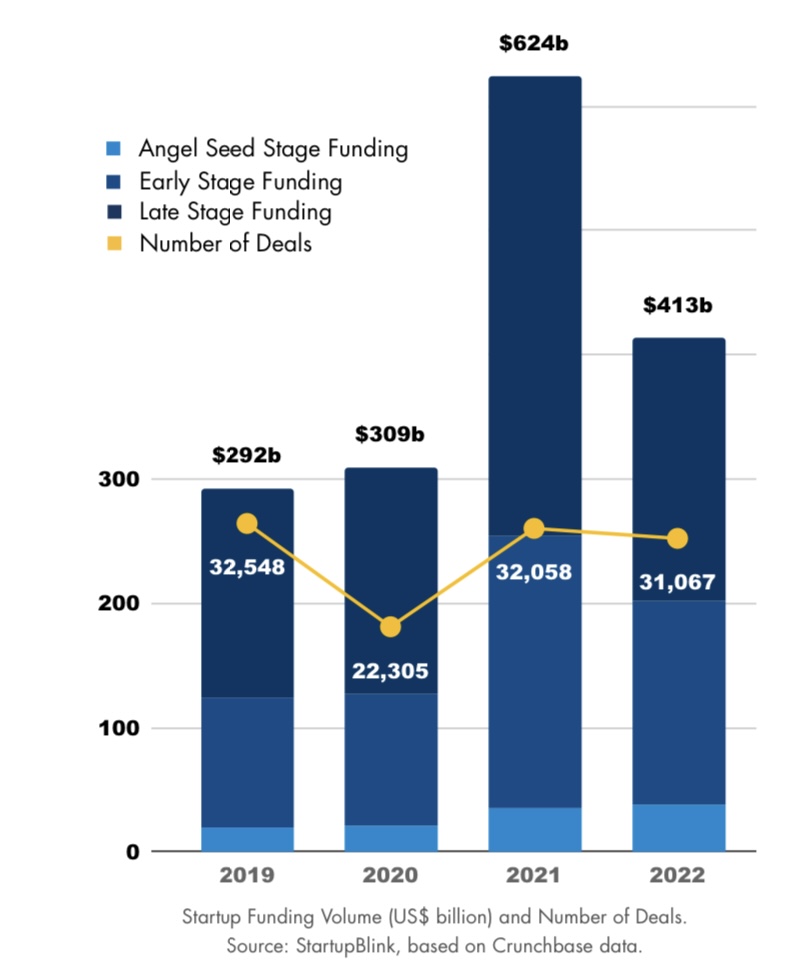The startup funding landscape has experienced a significant decline, according to the latest data from StartupBlink’s Global Startup Ecosystem Index 2023.
After a remarkable year in 2021, global startup funding in 2022 witnessed a substantial drop of over 30%.
This decline, which became more pronounced in the second half of the year, highlights a challenging period for the investment ecosystem. Let’s explore the key findings and implications of this decline in startup funding.
1. Funding Volume and Ticket Size
Crunchbase data reveals that the number of startup funding deals only saw a modest decline of approximately 3%, indicating that the decrease in funding volume was primarily due to a reduction in ticket size. In 2022, the average ticket size dropped from $19.5 million in 2021 to $13.3 million.
This shift emphasizes the importance for founders to prioritize early revenue generation over rapid growth, adapting their strategies to the changing investment climate.
2. Resilience of Early-Stage Investment
Despite the overall decline, angel-seed investments demonstrated resilience in 2022. This indicates that early-stage funding experienced a slight increase, highlighting the significance of supporting startups at their initial stages.
In contrast, late-stage investments suffered a significant 43% year-over-year fall, likely influenced by the decrease in value seen in publicly traded tech companies.

3. Challenging Start to 2023
The true impact of the decline in startup funding becomes apparent when examining the initial numbers for 2023. Crunchbase reports that global funding in the first quarter of 2023 stands at $76 billion, representing a staggering 53% decline compared to the $162 billion recorded in the same period in 2022.
To provide further context, if we exclude the massive investments made in OpenAI and Stripe during Q1 2023, the decrease would reach an even more substantial 63%. These figures indicate that challenging times lie ahead for startups seeking investment.
Implications and Recommendations
1. Adapt Funding Strategies
Startups should adjust their funding strategies in response to the declining investment landscape. Prioritize revenue generation, showcase the viability of your business model, and demonstrate the ability to achieve sustainable growth. Investors are likely to focus more on early revenue and profitability.
2. Focus on Early-Stage Funding
Considering the resilience of angel-seed investments, founders should pay attention to securing funding at the early stages of their startup’s development. Seek out angel investors, incubators, and accelerators that specialize in supporting early-stage startups, as they may be more inclined to invest in promising ventures.
3. Diversify Funding Sources
Reduced availability of traditional venture capital funding necessitates exploring alternative sources of capital.
Consider crowdfunding platforms, strategic partnerships, government grants, or industry-specific funds. Diversifying funding sources can increase the chances of securing investment during challenging times.
4. Emphasize Value Proposition and Traction
In a more cautious investment climate, clearly articulate your startup’s value proposition and highlight any traction, milestones, or customer acquisitions achieved. Investors will be seeking ventures that have demonstrated market validation and a strong value proposition.
Conclusion
The decline in startup funding as reported by StartupBlink’s Global Startup Ecosystem Index 2023 indicates a challenging period for entrepreneurs seeking investment.
With a substantial drop in funding volume and ticket sizes, founders must adapt their strategies, prioritize early revenue generation, and focus on securing early-stage investments. By emphasizing their value proposition, showcasing traction, and exploring alternative funding sources, startups can navigate these tough times and position themselves for future success.






![What to do as a Digital Marketer to Drive Results [Tips]](https://techeconomy.ng/wp-content/uploads/2023/05/images-2023-05-31T064855.894.jpeg)